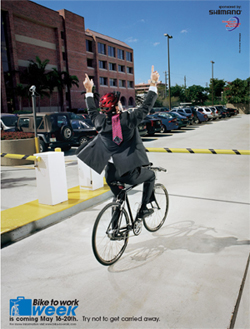
|
CONNECTIONS
|
IDAHO
ITD
HOME
IDAHO DMV
ITD NEWS
HIGHWAY
SAFETY
IDAHO STATE
POLICE
TRAVEL SERVICES
STATE OF IDAHO
NATIONAL
AASHTO
AAMVA
AAA of IDAHO
FEDERAL HIGHWAYS
FEDERAL AVIATION
IDAHO STATE POLICE
NHTSA
NTSB
TRB
U.S. DOT
Idaho
Transportation
Department
Public Affairs Office
P.O. Box 7129
Boise, ID 83707
208.334.8005
Fax: 208.334.8563
Email

Ridden
your bike lately?
Bike
to Work Day is May 20
With longer commutes and surging fuel costs, what better time to give bicycle commuting a try? Friday (May 20) is Bike to Work Day and is the largest concurrent bicycle commute in America. Bike to Work Week is May 16-20 and is part of May’s National Bike Month.
With fuel costs climbing towards $3 a gallon, bicycling to work becomes an attractive money-saving alternative to commuting by automobile. Bicycling just one day a week saves enough money in gas to treat yourself to lunch – plus, you arrive to work more refreshed and alert.
 Bicycle
commuting has become a viable transportation alternative for those looking
to save money, stay fit, and have fun. Surveys show that more than 30
percent of people who tried bike commuting for the first time last year
are still riding.
Bicycle
commuting has become a viable transportation alternative for those looking
to save money, stay fit, and have fun. Surveys show that more than 30
percent of people who tried bike commuting for the first time last year
are still riding.
As a rule, commuting to work will take about twice as long as driving, though a study by New York City’s Transportation Alternatives shows that trips less than 3 miles are often faster by bike, and those 5 to 7 miles long take about the same time.
Commuting by bike has a world of benefits including:
Can’t commit to a long commute?
Cut it in half. The first day, drive to work with your bike, then ride home that night. Ride to work the next morning, then drive home, and so on. Or drive halfway to a mall or other safe place, park your car, and ride the rest of the way. Bus services often allow bicyclists to bring their bikes on board, so you can ride your bike part of the way, then ride the bus the remainder of your trip.
Rules of the road
Bicyclists are required to follow the same basic road rules as motorists.
When cyclists follow traffic laws, traveling in a predictable fashion
and communicating their intentions to other road users, it increases
personal safety. It’s not just a good idea – in Idaho, it’s
the law.
According to the League of American Bicyclists, 85 percent of all serious bicycle crashes don’t even involve a moving car. Among the remaining accidents, most are avoidable. Cyclists who learn and obey the rules of the road have 80 percent fewer collisions than those who do not. Here are some essential safety tips:
-
Ride on the right, with the flow of traffic.
-
Be predictable. Avoid sudden swerves and stops. Signal when turning or stopping.
-
Be visible. Wear bright, reflective clothing. Use lights and reflectors in low-light conditions.
-
Obey all traffic signals including stop signs and lights.
-
Have at least one hand in control of your bicycle at all times.
-
Use bike lanes whenever possible.
-
Yield to pedestrians.
-
Ride defensively and respectfully. Watch for people who may not be looking for you, and be courteous to other users of the road. For more information, visit: